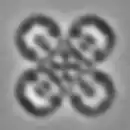Naphthalocyanine
Naphthalocyanine is a cross-shaped organic molecule consisting of 48 carbon, 8 nitrogen and 26 hydrogen atoms, it is a derivative of phthalocyanine. IBM Research labs used it for developing single-molecule logic switches[1] and visualizing charge distribution in a single molecule.[2][3]
Schematic and AFM image | |||
| Names | |||
|---|---|---|---|
| IUPAC name
21H,23H-Tetranaphtho[2′,3′:2,3;2′′,3′′:7,8;2′′′,3′′′:12,13;2′′′ ′,3′′′ ′:17,18]porphyrin | |||
| Systematic IUPAC name
[11(2)Z,13(8)Z,33(4)Z,7(81)Z]-12H,52H-2,4,6,8-Tetraaza-1,3,5,7(1,3)-tetrakis(benzo[f]isoindola)cyclooctaphane-11(2),13(8),33(4),7(81)-tetraene | |||
| Other names
Tetrabenzo[g]quinoxalino-2,3-porphyrazine | |||
| Identifiers | |||
3D model (JSmol) |
|||
| ChemSpider | |||
PubChem CID |
|||
CompTox Dashboard (EPA) |
|||
| |||
| |||
| Properties | |||
| C48H26N8 | |||
| Molar mass | 714.792 g·mol−1 | ||
Except where otherwise noted, data are given for materials in their standard state (at 25 °C [77 °F], 100 kPa).
Infobox references | |||
Naphthalocyanine derivatives have a potential use in photodynamic cancer treatment.[4]
References
- Liljeroth, P.; Repp, J.; Meyer, G. (2007). "Current-Induced Hydrogen Tautomerization and Conductance Switching of Naphthalocyanine Molecules". Science. 317 (5842): 1203–1206. Bibcode:2007Sci...317.1203L. doi:10.1126/science.1144366. PMID 17761878.
- Mohn, F.; Gross, L.; Moll, N.; Meyer, G. (2012). "Imaging the charge distribution within a single molecule". Nature Nanotechnology. 7 (4): 227–231. Bibcode:2012NatNa...7..227M. doi:10.1038/NNANO.2012.20. PMID 22367099.
- "Scientists image the charge distribution within a single molecule for the first time". Physorg.com. 2012-02-27. Retrieved 2012-02-27.
- Shopova, M.; Woehrle, D.; Mantareva, V.; Mueller, S. (1999). "Naphthalocyanine Complexes as Potential Photosensitizers for Photodynamic Therapy of Tumors". Journal of Biomedical Optics. 4 (3): 276–85. doi:10.1117/1.429930. PMID 23015248.
External links
- Timmer, J. (2007) Storing data in molecules: shifting atoms and flipping bits, ars technica online [accessed 8 September 2007]
This article is issued from Wikipedia. The text is licensed under Creative Commons - Attribution - Sharealike. Additional terms may apply for the media files.

